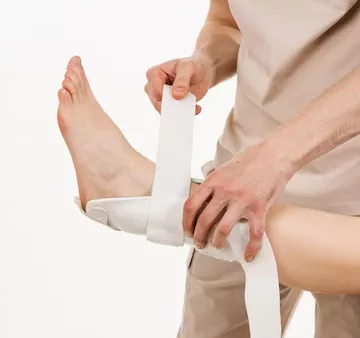What Is a Talar Dome Lesion?
The ankle is a complex joint integrating the lower end of the tibia (shinbone) and the superior aspect of the talus (anklebone). The talus has a dome shape at its top, which is thoroughly coated with cartilage, a durable, resilient tissue that facilitates smooth ankle motion. An injury to this cartilage and the underlying bone on the talus inside the ankle joint is known as a talar dome lesion. Other terms for this condition include osteochondral defect (OCD) and osteochondral lesion of the talus (OLT), with “osteo” referring to bone and “chondral” indicating cartilage.
Causes of Talar Dome Lesions
These lesions typically result from an injury, like an ankle sprain. If the cartilage fails to recover adequately after the injury, it may soften and start to fragment. Occasionally, a piece of the deteriorated cartilage and bone breaks away and floats within the ankle joint.
Symptoms of a Talar Dome Lesion
The development of symptoms can be slow and may take various months or even years post-injury. Common symptoms include:
- Persistent deep ankle pain worsening with weight on the foot, particularly during physical activities, and diminishing during rest
- An intermittent snapping or catching sensation while walking
- A feeling as if the ankle is locking or collapsing
- Swelling bouts in the ankle, usually when under load and reducing when at rest
Diagnosing Talar Dome Lesions
Diagnosing a talar dome lesion can be tricky as pinpointing the precise pain location is often difficult. The process involves the foot and ankle surgeon asking the patient about past injuries and performing an examination to check for pain, clicking, or restricted motion in the ankle.
Diagnostic measures may include an anesthetic injection into the joint to see if the pain subsides temporarily, indicative of joint-related pain. X-rays and possibly MRI or other imaging tests are typically ordered to assess the lesion and injury extent.
Nonoperative Treatment Options
The approach to treating a talar dome lesion depends on its severity. For stable lesions, without loose cartilage or bone pieces, treatment might include:
- Immobilization: Casting or use of a cast boot may be necessary to protect the talus. This might be accompanied by non-weight bearing exercises to maintain range of motion.
- Oral Medications: NSAIDs like ibuprofen can assist in alleviating pain and inflammation.
- Physical Therapy: Once the lesion has healed sufficiently, exercises to improve range of motion and strength are helpful. Pain reduction and swelling management techniques are also part of therapy.
- Ankle Brace: This can help prevent further injury, especially if the ankle is unstable.
When Surgery Is Required
Surgery may be the next step if the lesion doesn’t improve with nonsurgical treatments. The surgery aims to remove any bone and cartilage fragments and create a conducive healing environment. The optimal surgical technique is determined based on the individual case.
Potential Complications
Arthritis might develop in the ankle joint due to cartilage damage, leading to chronic pain, swelling, and limited motion. Management of these issues is typically guided by a foot and ankle surgeon and may involve:
- Anti-inflammatory medications (NSAID or steroidal)
- Physical therapy
- Bracing
- Surgical options



